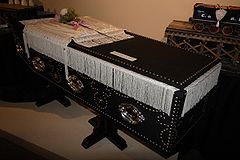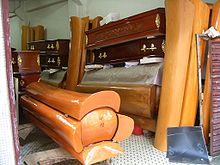- Coffin
-
A coffin is a funerary box used in the display and containment of dead people – either for burial or cremation.
Contemporary North American English makes a distinction between "coffin", which is generally understood to denote a funerary box having six sides in plan view, and "casket", which generally denotes a four-sided (almost always rectangular) box.[1]
Contents
Etymology
First attested in English 1380, the word coffin derives from the Old French cofin, from Latin cophinus,[2] which is the latinisation of the Greek κόφινος (kophinos), "basket".[3] The earliest attested form of the word is the Mycenaean Greek ko-pi-na, written in Linear B syllabic script.[4]
Any box used to bury the dead in is a coffin. Use of the word "casket" in this sense began as a euphemism introduced by the undertaker's trade in North America; a "casket" was originally a box for jewelry.[5] North Americans may draw a distinction between "coffins" and "caskets", using coffin to refer to a tapered hexagonal or octagonal (also considered to be anthropoidal in shape) box used for a burial and casket to refer to a rectangular burial box with a split lid used for viewing the deceased as seen in the picture above. Receptacles for cremated and cremulated human ashes (sometimes called cremains[citation needed] in North America) are called urns.
Practices
A coffin may be buried in the ground directly, placed in a burial vault or cremated. Alternatively it may be interred above ground in a mausoleum, a chapel, a church, or in a loculus in catacombs. Some countries practice one form almost exclusively, whereas in others it may depend on the individual cemetery.
The handles and other ornaments (such as doves, stipple crosses, crucifix, symbols etc.) that go on the outside of a coffin are called fittings (sometimes called 'coffin furniture' - not to be confused with furniture that is coffin shaped) while organising the inside of the coffin with fabric of some kind is known as "trimming the coffin".
Cultures that practice burial have widely different styles of coffin. In some varieties of Orthodox Judaism, the coffin must be plain, made of wood and contain no metal parts or adornments. These coffins use wooden pegs instead of nails. In China and Japan, coffins made from the scented, decay-resistant wood of cypress, sugi, thuja and incense-cedar are in high demand. Certain Aboriginal Australian groups use intricately decorated tree-bark cylinders sewn with fibre and sealed with adhesive as coffins. The cylinder is packed with dried grasses.[6]
Sometimes coffins are constructed to permanently display the corpse, as in the case of the glass-covered coffin of the Haraldskær Woman on display in the Church of Saint Nicolai in Vejle, Denmark or the glass-coffin of Vladimir Lenin which is in the Red Square in Moscow.
When a coffin is used to transport a deceased person, it can also be called a pall, a term that also refers to the cloth used to cover the coffin.
Design
Coffins are traditionally made with six sides, tapered around the shoulders, or rectangular with four sides. Continental Europe has favoured the rectangular coffin or casket, although variations exist in size and shape. In Medieval Japan, round coffins were used,which resembled barrels in shape and were usually made by coopers. (In the 1961 Kurosawa film Yojimbo, the protagonist, anticipating a shortage of coffins due to an impending battle (planned by Yojimbo) persuades several coopers to start making more coffins.) In the case of a death at sea, there have been instances where trunks have been pressed into use as a coffin.
They may incorporate features that claim to protect the body or for public health. For example, some may offer a protective casket that uses a gasket to seal the casket shut after the coffin is closed for the final time. In England, it has long been law that a coffin for interment above ground should be sealed; this was traditionally implemented as a wooden outer coffin around a lead lining, around a third inner shell. There are occurrences of coffins lined with or constructed from lead to bury radioactive-contaminated dead. However, in practice, after some decades have passed, the lead may ripple and rip. In the United States, numerous states require a vault of some kind in order to bury the deceased. A burial vault serves as an outer enclosure for buried remains, the coffin serves as an inner enclosure.
Some manufacturers offer a warranty on the structural integrity of the coffin. However, no coffin, regardless of its construction material (e.g., metal rather than wood), whether or not it is sealed, and whether or not the deceased was embalmed beforehand, will perfectly preserve the body. In some cases, a sealed coffin may actually speed up rather than slow down the process of decomposition. An airtight coffin, for example, fosters decomposition by anaerobic bacteria, which results in a putrefied liquefaction of the body, and all putrefied tissue remains inside the container, only to be exposed in the event of an exhumation. A container that allows air to pass in and out, such as a simple wooden box, allows for clean skeletonization. However the situation will vary according to soil or air conditions, and climate.
Coffins are made of many materials, including steel, various types of wood, and other materials such as fiberglass. There is emerging interest in eco-friendly coffins made of purely natural materials such as bamboo, willow or Banana Leaf.[7]
Custom coffins are occasionally created and some companies also make set ranges with non-traditional designs. These include printing or painting of peaceful tropical scenes, sea-shells, sunsets, cherubs and patriotic flags. Some manufacturers have designed them to look like gym carry bags, guitar cases, cigar humidors, and even yellow dumpster bins. Other coffins are left deliberately blank so that friends and family can inscribe final wishes and thoughts upon them to the deceased. In Taiwan, coffins made of crushed oyster shells were used in the 18th and 19th centuries.[citation needed]
Coffins are sometimes personalized to offer college insignia or different head panels to better reflect the deceased's life choices or aspirations: in Ghana, Seth Kane Kwei Carpentry Workshop in the 50's was at the beginning of a tradition, still alive under his grand son Eric Adjetey Anang who creates elaborate coffins built in the shapes of various mundane objects, like automobiles or aeroplanes, fish or pigs, onions or stools.
In the 1990s, the rock group Kiss released a customized Kiss Kasket, which featured their trademark makeup designs and KISS logo and could also be used as a cooler. Pantera guitarist Dimebag Darrell was buried in one.[8]
Cremation
With the resurgence of cremation in the Western world, manufacturers have begun providing options for those who choose cremation. For a direct cremation a cardboard box is sometimes used. Those who wish to have a funeral visitation (sometimes called a viewing) or traditional funeral service will use a coffin of some sort.
Some choose to use a coffin made of wood or other materials like particle board. Others will rent a regular casket for the duration of the services. These caskets have a removable bed and liner which is replaced after each use. There are also rental caskets with an outer shell that looks like a traditional coffin and a cardboard box that fits inside the shell. At the end of the services the inner box is removed and the deceased is cremated inside this box.
Industry
Traditionally, in the Western world, a coffin was made, when required, by the village carpenter, and he would frequently manage the whole funeral. The design and workmanship would reflect the skills of that individual carpenter, with the materials and brasses being the materials that were available at the time. In past centuries, if a pauper's funeral was paid for by the parish, the coffin might have been made of the cheapest, thinnest possible pine. At the other extreme, a coffin bought privately by a wealthy individual might have used yew or mahogany with a fine lining, plated fittings and brass decorations, topped with a decorated velvet drape.
In modern times coffins are almost always mass-produced. Some manufacturers do not sell directly to the public, and only work with funeral homes. In that case, the funeral director usually sells the casket to a family for a deceased person as part of the funeral services offered, and in that case the price of the casket is included in the total bill for services rendered.
Some funeral homes will have a small showroom to present families with the available caskets that could be used for a deceased family member. In many modern funeral homes the showroom will consist of sample pieces that show the end pieces of each type of coffin that can be used. They also include samples of the lining and other materials. This allows funeral homes to showcase a larger number of coffin styles without the need for a larger showroom. Other types may be available from a catalogue, including decorative paint effects or printed photographs or patterns.
Under a U.S. federal law, 16 CFR Part 453 (known as the Funeral Rule), if a family provides a casket they purchased elsewhere, the establishment is required to accept the casket and use it in the services. If the casket is delivered direct to the funeral home from the manufacturer or store, they are required to accept delivery of the casket. The funeral home may not add any extra charges or fees to the overall bill if a family decides to purchase a casket elsewhere. If the casket was bought from the funeral home, these Regulations require bills to be completely itemized.
See also
References
- ^ Mattioli, Dana (Feb 24 2010). "Casket Makers Dig In as Sales Take Hit". The Wall Street Journal. http://online.wsj.com/article/SB10001424052748704511304575075811946202750.html?KEYWORDS=casket.
- ^ cophinus, Charlton T. Lewis, Charles Short, A Latin Dictionary, on Perseus Digital Library
- ^ κόφινος, Henry George Liddell, Robert Scott, A Greek-English Lexicon, on Perseus Digital Library
- ^ Palaeolexicon, Word study tool of ancient languages
- ^ casket, coffin (nn.) from the Columbia Guide to Standard American English via Bartleby.com
- ^ Bark coffin, National Museum of Australia
- ^ Bamboo Coffins "Coffin-maker resurrects tradition", from BBC Business News, published 2001-12-28
- ^ "Kiss...Forever: Official 'Kiss Kaskets' Let Kiss' Fans Rock and Roll for Eternity"]. Signatures Network. June 12, 2001. http://www.signaturesnetwork.com/press.php?diary_id=13&mode=view. Retrieved May 21, 2006.
External links
- National Museum of Australia Aboriginal bark coffins
Categories:- Chinese inventions
- Coffins
- Death customs
Wikimedia Foundation. 2010.






